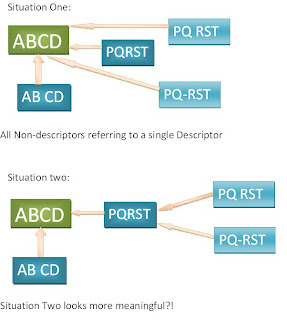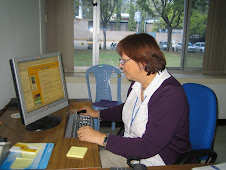Sunday, January 31, 2010
Completion of AGROVOC First Phase
Thursday, December 17, 2009
Relationships
Friday, October 23, 2009
AGROVOC Work in progress
The taxonomic classification and its hierarchical relations are consuming much of our time. But we are doing our best to give the better hierarchy. Meanwhile we are also playing around with new AGROVOC Concept Server work bench and it is pretty good that it has become little bit faster with the full AGROVOC version.
Tuesday, October 6, 2009
Sunday, May 17, 2009
Finally...reached the end of the tunnel!
 We plunged into the revision of taxonomic names about a couple of months back and finally we are out of the tunnel, carrying with us a bundle of relationships that require a little more discussion to decide and fix. I was handling plant names and Lavanya was handling insect names and we are going to share and reflect upon Our Common Problems, one taxonomic name applicable for two different common names, one common name referring to two different taxonomic names and the like.
We plunged into the revision of taxonomic names about a couple of months back and finally we are out of the tunnel, carrying with us a bundle of relationships that require a little more discussion to decide and fix. I was handling plant names and Lavanya was handling insect names and we are going to share and reflect upon Our Common Problems, one taxonomic name applicable for two different common names, one common name referring to two different taxonomic names and the like.
Saturday, March 28, 2009
What's in a name?

Sometimes it is semantic relations ingrained!
 I could not resist my temptation to read through the entire wikipedia article when I saw this interesting picture while refining Myrtaceae terms. It is the fruit of Jabuticaba, also called Brazilian Grape Tree. The name is derived from the Tupi word Jabuti (tortoise) + Caba (place), meaning the place where you find tortoises. Aspects of biodiversity and ecological interdependency are brought out in these names in indigenous communities. Even scientific names are suggestive of the main feature of the organism. Myrciaria cauliflora aptly represents the fact that its flowers grow directly from its trunk.
I could not resist my temptation to read through the entire wikipedia article when I saw this interesting picture while refining Myrtaceae terms. It is the fruit of Jabuticaba, also called Brazilian Grape Tree. The name is derived from the Tupi word Jabuti (tortoise) + Caba (place), meaning the place where you find tortoises. Aspects of biodiversity and ecological interdependency are brought out in these names in indigenous communities. Even scientific names are suggestive of the main feature of the organism. Myrciaria cauliflora aptly represents the fact that its flowers grow directly from its trunk.
Wednesday, March 25, 2009
Bharati Joins AGROVOC Team
 Bharati joined as Senior Research Fellow, Knowledge Management & Sharing Division of ICRISAT. She is a post graduate in Agricultural Biotechnology from University of Agricultural Sciences, Dharwad. She is currently working on AGROVOC and will be refining the RT relationships. Together Lavanya and Bharati are reviewing the hierarchies under each top term to see if they need to be revised further.
Bharati joined as Senior Research Fellow, Knowledge Management & Sharing Division of ICRISAT. She is a post graduate in Agricultural Biotechnology from University of Agricultural Sciences, Dharwad. She is currently working on AGROVOC and will be refining the RT relationships. Together Lavanya and Bharati are reviewing the hierarchies under each top term to see if they need to be revised further.
Tuesday, March 17, 2009
Land mobility
 “Land mobility” is the movement of land parcels between farmers through sales or exchange. - (FAO Land Tenure Training Materials on Land Consolidation Pilot Projects)
“Land mobility” is the movement of land parcels between farmers through sales or exchange. - (FAO Land Tenure Training Materials on Land Consolidation Pilot Projects) This concept is gaining importance in the wake of urban-rural migration, expansion/encroachment of urban structures (roads and buildings) into rural areas, political promises and women asserting their property rights.
This concept is gaining importance in the wake of urban-rural migration, expansion/encroachment of urban structures (roads and buildings) into rural areas, political promises and women asserting their property rights.
Poly-hierarchies and the two proposals
(organisms, such as "Apis mellifera capensis" over categories such as "Queen
bees")... but unfortunately this is what we would end up to have (and is fine
for now). The tools should takes care to visualize or not all the common
names or scientific names or exclude part of them.
After a deeper analysis i found that in your picture we may have problems in
agrovoc or in the concept server as we are planning. Therefore I am proposing
2 possible solutions:
3a) mix the hierarchies in order to have a unique hierarchy.
3b) keep hierarchies separated, in this case just relate concepts that may
belongs to the 2 hierarchies by RT (refined appropriately).
Personally I like better case 3b, which is similar to consider the
potato-plant organism different from the potato-fruit organism.... so
consider the 'bee' organisms related the the 'bees' as a specific category of
insects. I like very much this idea. - Ms. Sini Margherita
Even the other team members voted for option 3b.
Some thoughts on Polyhierarchies
is likely to create some confusion.
Instead we prefer to have common terms as one hierarchy with organisms as Top
term and taxonomic terms as another hierarchy with some other top term, say
taxonomic terms.
It will be a `ladder' structure with the rungs formed by the `sameAs'
relations. It is almost similar to the original guidelines, but for that now
MORE (two) descriptors are allowed for the same concept.
(Note: common terms hierarchy may not exactly be parallel to the taxonomic
one. There could be some gaps, as in the case of sub order, and sub genus
levels, in which case the sameAs relation doesn't exist)
This seems to be alright from the thesaurus point of view, but we are not
sure how it fits into the concept server and work bench contexts,
particularly when we want to expand the search for all the stem borers.
To achieve this, should we necessarily have all kinds of stem borers as NTs
under stemborers? When they are in different hierarchies also, they can be
brought together by RT relation. If RT relation is not amenable for handling
in the concept server, should we devise any other new relation, say SC (Same
Concept) or ST Same term?
Since at present all the common names and taxonomic names are mixed up, we
would first add and/or link common names to existing taxonomic names, and
taxotomic names to existing common names.
Catching up with running time!

With the approaching deadlines, AGROVOC team was away from this blog for a while, taking stock of the situation and working on ways to take this mammoth task to completion. With more team members on board now, the revision and refinement process has gained momentum and heading towards the finish line.
Monday, February 2, 2009
Sabitha joins AGROVOC team
All the best ...Priyanka ...
 ...for your new life journey. Wedding bells are ringing for Priyanka. 30th January had been her last working day at ICRISAT (at least in the first innings). It was a day of sweet n sour excitement as it was the last working day for two of our colleagues, Priyanka and Pritpal. Ms. Pritpal is also getting married this month. She has been working on topic maps and concept maps.
...for your new life journey. Wedding bells are ringing for Priyanka. 30th January had been her last working day at ICRISAT (at least in the first innings). It was a day of sweet n sour excitement as it was the last working day for two of our colleagues, Priyanka and Pritpal. Ms. Pritpal is also getting married this month. She has been working on topic maps and concept maps.
Priyanka plans to pursue a career in Fashion designing after her marriage. In fact, AGROVOC donned its new outfit largely because of Priyanka's painstaking efforts in weaving together the revised specifications from excel sheets into BT/NT/RT relations in the refinement tool. Understanding the relations from the excel sheet and making the changes to the master copy was a difficult task. She did everything with a simple smile without a complaint. But I could see the strain in her eyes after doing that monotonous and intricate job. All the best ...Priyanka ... from AGROVOC team at ICRISAT.
Tuesday, January 27, 2009
A non-descriptor referring to two Descriptors
Alternative agriculture.
Biological farming includes:
* organic farming
* biodynamic farming
Making `Biological farming' a Descriptor is still undecided. In case it is left as a Non-descriptor, I would like to make it a broader synonym of `organic farming' as well as `biodynamic farming'.
Now my dilemma is:
(1) Should `biological farming' be made a Descriptor and NT under alternative agriculture? Should `organic farming' and `biodynamic farming' become NTs under `biological farming'?
(2) Should `biological farming' be left as a Non-descriptor and refine it as a `nearSynonym' for `alternative agriculture'? (or) Can I make it a `broaderSynonym' for both `organic farming' and `biodynamic farming'?

(image source: http://info.asapsupplier.com/index.php?pageid=1225)
Monday, January 26, 2009
Refining RTs

queen bees
BT honey bees
RT queenlessness
RT Requeening
How should these RTs be refined? queenlessness isPropertyOf queenbees? Or something better? and
honey bees `isObjectOfActivity' requeening?
Background:
There were about 2,090 ref. for `Queenlessness' in google search. It seemed to be an important concept and hence was made a descriptor. It is placed under state and the USE term, 'queen bees' is made an RT.
'Queenrightness' is the presence of queen bee and didn’t seem to be an important descriptor. (Only when something goes wrong, it becomes important!) Therefore Queenrightness is left as a non-descriptor, but is made a non-descriptor for 'queenlessness' instead of for `queenbees' and refined as `antonymOf’.
Tuesday, December 30, 2008
It would not have been possible before!

Without Wikipedia, it would not have been possible for me to work on AGROVOC. I owe a lot to Wikipedia!

Sunday, December 28, 2008
Thursday, December 25, 2008
Thursday, December 18, 2008
"Features" as a new topterm
Proposal of new top term "features"
While searching BT for 'genetic maps' we came across the term "genomic feature", which would be the BT for genetic maps. This term was proposed by Ms. Jayasree Balaji(Scientist, Bioinformatics and Biotechnology, ICRISAT) when we had discussion with her on some of the genetics terms which doesn't have BT. With the out come of this discussion we thought of proposing new top term "features". The same discussion was conveyed to Ms.Gudrun and Ms. Margherita on skype meeting, they also agreed to add this top term.
Monday, December 15, 2008
Sunday, November 30, 2008
A very eventful month for AGROVOC team at ICRISAT

Ms. Gudrun Johannsen's visit to ICRISAT made the month very eventful for ICRISAT's AGROVOC team. Gudrun Johannsen - Senior Information Specialist, FAO, has been working on the AGROVOC Thesaurus since 1990, and also participated in its translation into German. Currently she is responsible for the content management of AGROVOC.
Ms. Gudrun has been at ICRISAT to guide the team in finalizing the BT/NT relationships, particularly the genetics and plant breeding terms. She has been adding useful information resources to an already long list of thesauri including the NAL thesaurus, GEMET thesaurus,the Biocomplexity thesaurus, FAOTERM, the MeSH browser and the all inclusive World Bank Thesaurus. (It never denies!)

We see her going patiently and passionately through each of the resources till she finds a convincing definition or explanation. It was an inspiring and instructional interaction for us and this would not have been possible through e-mails or skype conferences.
Tuesday, November 4, 2008
A non-descriptor to a non-descriptor?!
Semantic relationships
the equivalence relationship,
the hierarchical relationship and
the associative relationship
and there are three kinds of hierarchical relationships:
Generic relationship
Instance relationship
Whole-part relationship
The `Whole-part' relationship is between terms where one concept is inherently included in another. Four major types of this relationship occur:
systems and organs of the body,
geographic locations,
disciplines or fields of discourse, and
hierarchical organizational, corporate, social or political structures.
(Source: Consumer Egg Thesaurus - http://www.slais.ubc.ca/COURSES/libr512/01-02-wt2/thesauri/Eggs/structure.htm)
New Top Terms

`Strategies' and `Systems' are the new top terms proposed. Addition of `Events' as another Top Term is also being considered. Already `Phenomena' and `Resources' were added to the initial list of Top Terms. It was decided to keep `Technology' as a separate top term. Now, we find that it is a top term in the subjects listing of `Knowledge 2008' portal as well. (http://www.success.co.il/knowledge/encyclopedia/index.html)
The Discovery of an Information Resource

We understand that it is not a totally new resource, but that it is STANDS4 that has morphed into Abbreviations.com. "Abbreviations.com is a unique reference resource which focuses entirely on definitions and classifications of short hands such as acronyms, abbreviations and initialisms. It is backed up by a large community of volunteering editors and it provides its users with a diverse disciplines directory, a state of the art meta-search engine and free desktop search tools."

We are particularly happy with the elegant design and lay out of the site. I was quickly scrolling down to see the pictures that our word in question has pulled in. I make a visual guess and very often I find images that are quite close to my guess! It is indeed a very handy tool while adding pictures to messages and presentations.

We were very happy to find some good definitions and I was double happy when I didn't find something, as there is a `Get a Free T-Shirt Offer' on becoming an editor!
Monday, October 6, 2008
Of the terms - Land and Landscape
 In Agrovoc, Landscape is an NT under under Land. For indexing, such type of grouping was found to be convenient. But in the revised version, only `is a' relation and `instance of' relation define the BT/NT relationship.
In Agrovoc, Landscape is an NT under under Land. For indexing, such type of grouping was found to be convenient. But in the revised version, only `is a' relation and `instance of' relation define the BT/NT relationship.Since, the relation between Land and Landscape is neither an `is a' relation nor `an instance' relation, Landscape cannot be an NT under Land. It can at best be an RT.
Then, what should be the BT for Landscape? Should it be Physiographic features? Please comment.
(Note: The UF ref. for Physiographic features is Physical landscape features, i.e. Physical landscape features USE 5834 - Physiographic features)
Wednesday, September 24, 2008
Botany Vs Plant sciences
Could there be some reason for giving them separately?
One possibility is that Plant sciences could be that part of botany dealing with higher plants while Phycology(Algology) and Mycology deal with algae and fungi respectively.
Another possibility is that Plant sciences includes botany and perhaps other subjects as are applicable to plants. (examples could be chemistry concerning the extraction and distillation of plant products, pharmacology concerning the use of plant constituents for medicines etc.)
Please comment.
Tuesday, September 23, 2008
Top Concepts
The starting points in AGROVOC will the Top Concepts - Super BT or TT.
Based on the analysis of FAO staff, the following 14 Top concepts are suggested:
Activity

Entity
Group
Location
Measure
Method
Object
Organism
Process
Property
State
Subject
Substance
Time
Later on `Phenomena' is also added to this list.

Ms. Lavanya, Ms. Geetanjali, Ms. Prasanthi and Ms.Priyanka can keep these categories in mind and post the terms in their areas of work into these categories.
Monday, September 22, 2008
FAO guidelines for Managing AGROVOC
Basic Guidelines for Managing AGROVOC
document available at ftp://ftp.fao.org/docrep/fao/010/ai144e/ai144e00.pdf
The document is prepared by Margherita Sini, Gudrun Johannsen, Gauri Salokhe, with the contribution of Anita Liang and Dagobert Soergel. It covers the topics like:
Resources for translations and maintenance, Guidelines for translations, Adding new terms to AGROVOC, General conventions, Managing relationships in AGROVOC – using the maintenance tool and the refinement tool, AGROVOC structure and content revision, and AGROVOC online
AGROVOC term searching made more versatile
starting with end with containing text exact match exact word
...when I was routinely copying a word in the search window. This bonanza of options would really help searchers to do all kinds of (gimmicks) string based searches. On several occasions, I felt the need for something like `end with' option, but it remained latent until someone asked for that particular feature during the Agrovoc e-conference.
Thanks to Ms. Sini Margherita who worked for long hours over this weekend to save several (wo)man-hours now for those of us who are working on Agrovoc refinement and several hours of the future Agrovoc users. It is indeed a stitch in time!
Thursday, September 11, 2008
RT refinement - Issue no. 3
Now the RT s linked to the sci. taxonomic name in the former hierarchy are linked to the common name, which in turn linked to the sci. tax. name. Is it alright?

Monday, September 8, 2008
Online tutorial to carry out AGROVOC refinement
The following modules are planned.
Module 1: What is AGROVOC?
Module 2: How is AGROVOC structured?
Module 3: AGROVOC Revision and Refinement
Module 4: Description of Tasks
Module 5: Specifying Revisions and Refinements in an Excel Template
Saturday, September 6, 2008
Online tutorial modules for guiding the new members of AGROVOC team
The PPT presentation developed during the initial stqages of the project will be revised and used for this purpose.
A message was posted on Km4dev-l seeking to suggest any guidelines or manuals.
Ms. Nancy White has suggested to contact IMARK team at FAO - http://www.imarkgroup.org/index_en.asp
Friday, September 5, 2008
Discussions and Doubts
Clarification required on: Issue 1
Should Taxus baccata be made an NT under all the four Related Terms – Drug plants, Hedging plants, Timber trees and Ornamental woody plants? This is just one example.
| | UF | 15460 - Yews (EN) | |
| | UF | 74892 - this term does not exist in EN | |
| | BT | 7625 - Taxaceae (EN) | |
| | NT | 7633 - Taxus baccata (EN) | |
| | RT | 2393 - Drug plants (EN) | |
| | RT | 3530 - Hedging plants (EN) | |
| | RT | 7776 - Timber trees (EN) | |
| | RT | 34067 - Ornamental woody plants (EN) | |
| | RT | 34917 - Taxol (EN) |
Clarification required on: Issue 2
(Term code 4333) Liliiflorae: This order corresponded roughly to the later order Liliales. Today Art 17 forbids the use of this name in the rank of order.- Near synonym – how to handle this?
Agrovoc Revision and Refinement work gains momentum
Monday, August 11, 2008
Virtual tour of Plant biodiversity
 Thanks to the Agrovoc Refinement project for it has given me an opportunity to have a virtual tour of the fairer species of nature's creation. Even if I had become a horticulturist as I wished during my childhood days, I wouldn't have been able to grow those many of them. Moreover, for this assignment I don't delve deep into the technical nuances but would be only visiting each of the taxonomic divisions looking for synonyms of common names and scientific names. This makes me feel like a butterfly moving from a bush here and a flower there, lapping up the sweetness of language manifested in the common names of plants.
Thanks to the Agrovoc Refinement project for it has given me an opportunity to have a virtual tour of the fairer species of nature's creation. Even if I had become a horticulturist as I wished during my childhood days, I wouldn't have been able to grow those many of them. Moreover, for this assignment I don't delve deep into the technical nuances but would be only visiting each of the taxonomic divisions looking for synonyms of common names and scientific names. This makes me feel like a butterfly moving from a bush here and a flower there, lapping up the sweetness of language manifested in the common names of plants.
Tuesday, June 17, 2008
Please clarify to classify !

While organizing the terms into a semantic web, I sometimes wonder where to put certain terms! Some terms seem to belong to more than one category, with the different meanings they connote as a noun and as a verb. Certain other terms seem to remain aloof, not fitting into any of the identified categories. (Pl. see the previous post for the categories)
We earnestly request you to think over the following terms and help us to classify them better. You can give your comments in the comments field.
Mankind
Individuals
Occupations
Entrepreneurship
Risk
Needs
Agrovoc terms being organized under Top Concepts
In the process some of the non-descriptors having UF and UF+ relations are converted into descriptors and made as NTs under appropriate terms.
Each of the revised relations are being reviewed by Ms. Sini Margherita and Ms. Gudrun Johannsen of the FAO.
Friday, February 29, 2008
A semantic marathon!

Before embarking on the task, some hierarchies in AGROVOC are studied to feel the tips of the iceberg.
After this, hierarchies of each top term, i.e. terms without ant BT relation are studied alphabetically.
Task to be accomplished
1) Revision and refinement of all BT/NT relationships and identification of real hierarchical relationships which can be represented as ‘suclass of” / “is_a” or as “is an instance of”. (28,625 BTs and 28,617 NTs)
2) Revision and refinement of all RT relationships. (28,219 RTs)
3) Revision of scientific terms and corresponding common names.
4) Revision of all terms which do not have broader terms and identify those that can to be assigned to one or more broader terms.
5) Revision and refinement of USE/UF/UF+ relationships. (19,158 Use, 17,386 UF and 1,775 UF+)












